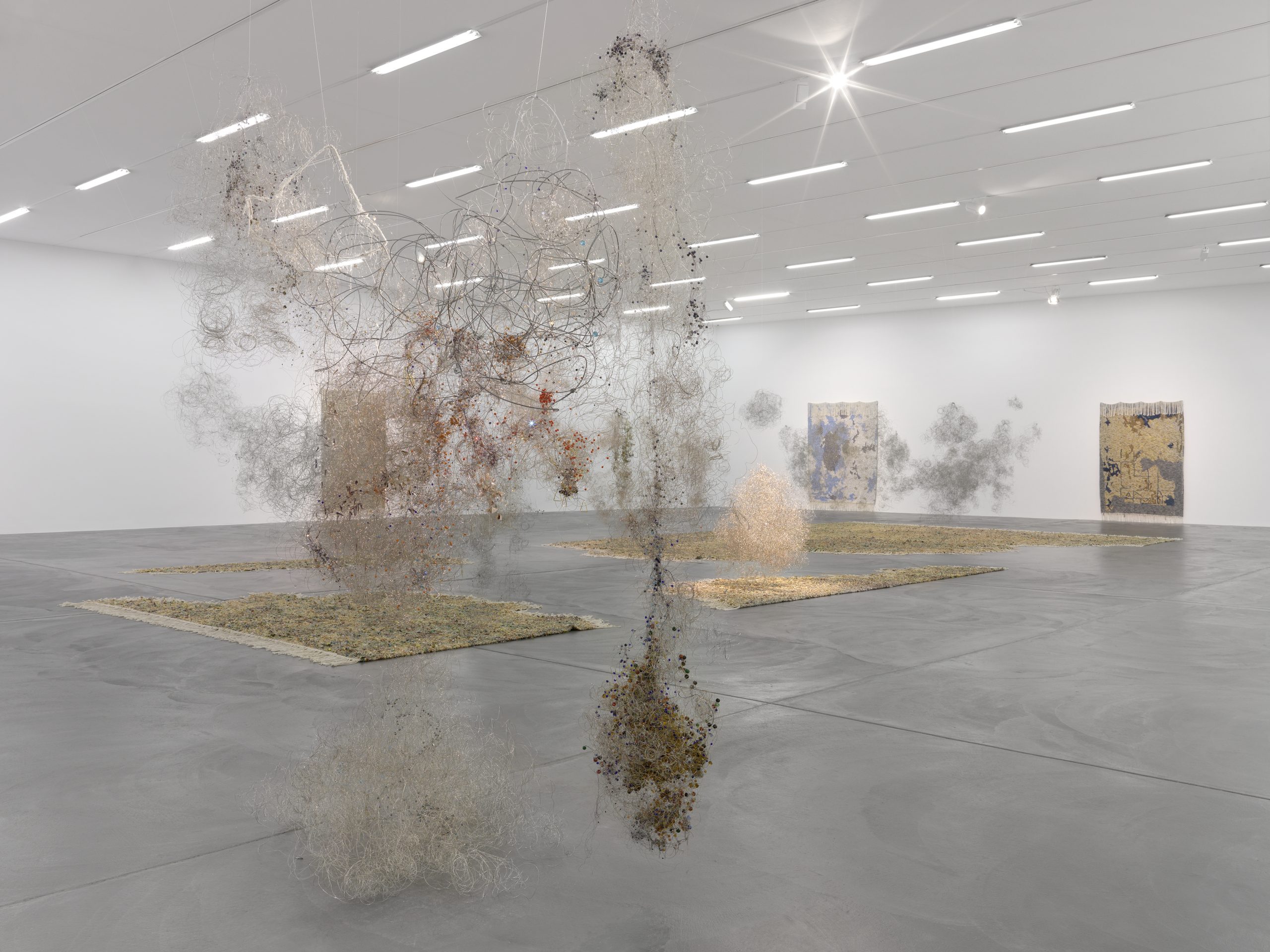IGSHAAN ADAMS – KICKING DUST
[vc_row][vc_column][vc_column_text]*Featured photo: Igshaan Adams, Kicking Dust, Kunsthalle Zürich, 2022, installation view, photograph: Annik Wetter[/vc_column_text][vc_separator color=”chino” border_width=”2″][vc_column_text]05 Febbraio –22 Maggio 2022
Kunsthalle Zürich, Limmatstrasse 270, CH-8005 Zürich
A cura di Tarini Malik (Hayward Gallery) and Daniel Baumann (Kunsthalle Zürich)
info@kunsthallezurich.ch | www.kunsthallezurich.ch | phone +41 44 272 1515[/vc_column_text][vc_column_text]La Kunsthalle Zürich presenta la prima grande mostra personale di Igshaan Adams in Europa continentale che arriva in Svizzera dalla Hayward Gallery di Londra, dove è stata esposta da maggio a luglio 2021.
La mostra Kicking Dust si presenta come un parco, un paesaggio che ci assorbe e ci circonda di quotidianità, desideri, narrazioni e innumerevoli contrasti.
L’arte di Igshaan Adams parla di radici, di religione e sessualità, collegando il vicino, il distante e l’apparentemente contraddittorio. Arazzi tessuti, sculture di filigrana e strutture in espansione creano un ponte tra gli opposti. Tessono fili, trattengono e intrecciano idee. La sua arte è astratta, poetica e allo stesso tempo fondata su esperienze vissute. Assorbe i visitatori ma lascia spazio e tranquillità per riflettere. La mostra Kicking Dust ricorda un giardino o un parco attraversato da sentieri visibili e invisibili, desideri e ricordi.
Igshaan Adams (nato nel 1982) vive e lavora a Città del Capo, in Sudafrica. La sua biografia, come racconta nelle interviste, è plasmata dalla consapevolezza che molti fattori concorrono a formare una persona, ma anche una società – molti elementi che apparentemente non possono essere collegati o che addirittura sembrano escludersi a vicenda. Adams è nato nel 1982 a Bonteheuwel, una township segregata a Città del Capo creata tra il 1961 e il 1964. Durante l’apartheid, le comunità Black e ‘Coloured’ (una classificazione che definisce persone di etnie miste) furono costrette in parti della città che erano considerate aride e non desiderabili. Come creolo con origini malesi, Adams fu classificato come Coloured. Musulmano praticante, cresciuto con nonni cristiani, e apertamente omosessuale, egli occupa una posizione fragile all’interno di questa comunità religiosa.[/vc_column_text][vc_single_image image=”46414″ img_size=”full” add_caption=”yes” alignment=”center” onclick=”link_image”][vc_column_text]L’arte di Adam non è implicitamente biografica. Non è figurativa o aneddotica, ma astratta – e tuttavia estremamente rappresentativa. Il materiale è centrale: nel caso di Adams corde, perline di vetro, plastica, legno, seta, vetro o stoffa, sono tessuti in grandi tappeti o installazioni spaziali. Alcune opere sono realizzate dallo stesso Adams, anche se spesso è assistito da donne che padroneggiano tecniche di tessitura tradizionali tramandate da generazioni. Attraverso questa collaborazione, le tradizioni, le idee e le storie degli altri confluiscono nel suo lavoro.
La tessitura è un mestiere antico, in cui il semplice intreccio di materiali crea elaborate superfici. Attraverso la pazienza e la cura, il lavoro di Adams trasforma e ricicla materiali umili e quotidiani in composizioni opulente di una bellezza straordinaria. La tessitura di Adams è trasparente in quanto ogni elemento rimane indipendente, anche se è saldamente integrato: una perla di vetro rimane una perla di vetro, ma in combinazione con altre diventa qualcosa di nuovo. La tessitura unisce senza dissolvere le differenze. Questo dà origine a spazi pittorici e installazioni ambientali che ci inglobano come partecipanti, come se fossimo una perlina. Il visitatore diventa parte del processo e tuttavia rimane autonomo. Le installazioni di Adams sono quindi spazi di esperienza. Possono essere fisiche, estetiche, trascendentali o persino religiose, e sono sempre di grande impatto.
Kicking Dust, il titolo della mostra, si riferisce a una danza indigena sudafricana che Adams osservò da bambino nella comunità Nama dei suoi nonni nel Northern Cape. Descritta come “danza nella polvere”, la danza è un rituale di corteggiamento in cui nuvole di polvere sorgono dal suolo quando gli esecutori calciano energicamente il terreno asciutto. Nella mostra, sculture simili a nuvole fatte di filo a spirale e perline si librano nello spazio, in risonanza con l’immagine della polvere in movimento, sollevata dalla terra. ‘Kicking dust’ può essere intesa come un’allegoria dell’arte in generale, come un’attività che getta in aria cose. La polvere è niente, la polvere è tutto, è come il tempo, indifferente ed essenziale. Igshaan Adams ha un enorme talento per la delicatezza e una comprensione del tempo da poeta, di come questo può erodere e segnare la nostra vita quotidiana”. (Hilton Als)
Igshaan Adams è rappresentato dalle gallerie Blank projects (Città del Capo) e Casey Kaplan (New York).
Un film realizzato in collaborazione con Nowness, Hayward Gallery e Kunsthalle Zürich permette di dare uno sguardo alla pratica e all’opera dell’artista. Può essere visto sul sito della Kunsthalle Zürich.[/vc_column_text][vc_single_image image=”46416″ img_size=”full” add_caption=”yes” alignment=”center” onclick=”link_image”][vc_separator color=”chino” border_width=”2″][/vc_column][/vc_row]
